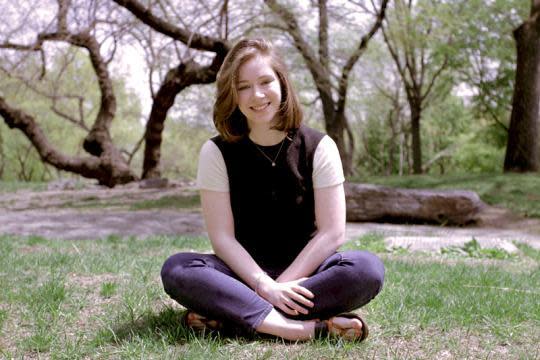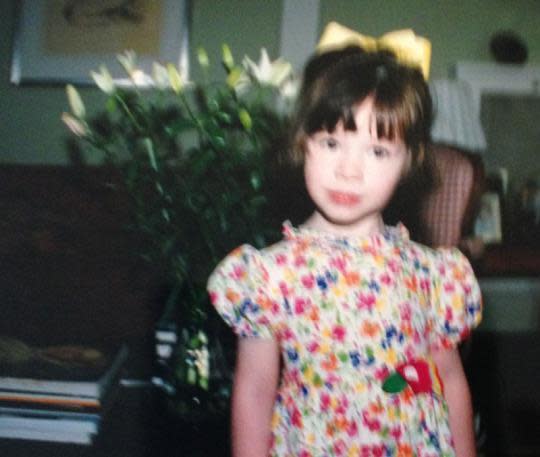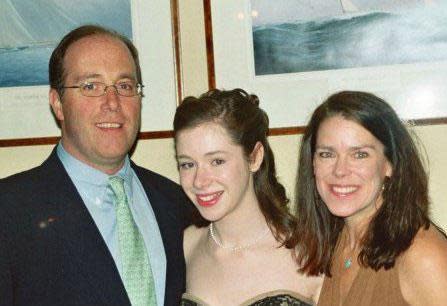I’m 24 and Have Lived with Lyme Disease for 16 Years

After years of being angry, misdiagnosed, and misunderstood, Allie Cashel has found peace. Now she’s speaking out about her lifetime with chronic Lyme disease — and sharing the stories of others with the condition. (Photo: Lily Coleman)
By Allie Cashel, as told to Amy Rushlow
I was first diagnosed with Lyme disease when I was 7 years old. I was living in Westchester County in Irvington, N.Y., which is the one of the most endemic areas for Lyme disease. I was bitten by a tick, had the classic bull’s eye rash, and tested positive right away. I took my antibiotics, and the assumption was that I was fine. It was how we all understood the disease to be at that time.
As I started to grow up and I first reached puberty, I had a lot of problems with what seemed like symptoms of arthritis. Rheumatoid arthritis (RA) runs in my family, and so we thought that’s what it was. I would often have so much pain and clawing in my hands that I would not be able to hold my pencil — I would drop my pencil in the middle of class and things like that. When there is intense joint pain, especially in somebody so young, RA is the expected diagnosis. But when I went to the doctor, all my blood work was clear. It wasn’t arthritis.

Allie Cashel at age 7, when she was diagnosed with Lyme disease for the first time. (Photo courtesy of Allie Cashel)
I was diagnosed with Lyme for the second time in eighth grade. I was having a lot of trouble walking during my eighth grade graduation — the arthritis symptoms in my knees were that bad — and there was a doctor locally who was treating Lyme disease. I was tested again, and then diagnosed again. I was also diagnosed with three other common infections associated with Lyme that you also get from the bite of a tick, which had gone untreated for years at that point.
I am the oldest of five, so my house was always busy and we were always “go, go, go” kind of people. For a long time I just understood my symptoms as me being my weird me, and there was something strange that I could not do as well as my siblings and that I could not do as well as my friends.
When I came to understand that it was a real, physical problem, in many ways I was angry about it, because it became something that was harder for me to ignore. The pain was something that I didn’t really have to talk about while I was growing up. But then when I was diagnosed again in eighth grade, I started going to doctor’s offices for treatments, I had to talk about how I was feeling, and they were asking all of these intrusive questions. As a 13-year-old, you are going through puberty, so you do not want to talk about your body at all. I felt like, “I cannot believe that now is the time that I have to talk about it.” But eventually I started to understand the disease and get treatment. I was getting better, and I was in less pain all the time.
Related: Avril Lavigne: ‘I’m Doing a Lot Better’ after Lyme Disease Treatment

My senior year of high school was the first time that I ever experienced any neurological symptoms of the disease. I was speaking with an intense stammer. I had six car accidents in six weeks. My brain was just not connecting with my body in the way it was used to connecting.
My family had moved to Boston, and I went to see a new doctor there. I was shocked by the immediate dismissal of any possible relation to Lyme. I was basically told that I was having a psychological breakdown in response to my parents’ moving and it was impossible that what was happening to me was related to the disease.
To have a 17-year-old girl come to your office, and for you to say, “I am sorry, it is impossible that that is what is happening to you, and I actually just think it is all in your head,” I was shocked by that. It had incredibly damaging effects on my psychology and my ability to communicate about this disease. That shattered my faith in myself, and my faith in my own understanding of what was happening.

Writer and chronic disease advocate Allie Cashel is pictured with her parents at age 16, one year before she started experiencing serious neurological symptoms associated with Lyme disease. (Photo courtesy of Allie Cashel)
I went back to my regular Lyme specialist, Bernard Raxlen, MD, and fortunately he was able to connect the dots and treat the infection, babesiosis, that was contributing to the mental symptoms.
After my experience with neurological symptoms in my senior year of high school, I was incredibly angry. I was angry that it affected me in the way that it has. I was angry about the way that it existed in the world, and the way that I could not talk about it with anybody, and that nobody understood it and doctors did not believe me. I was so, so angry.

During my senior year at Bard College, I had to complete a senior thesis. I decided to write about something I knew and chose Lyme disease, but I wasn’t ready to talk about my own experiences. So I started interviewing people with the disease. I completed about 25 interviews, which would form the basis for my upcoming book, Suffering the Silence: Chronic Lyme Disease in an Age of Denial.
Many of the people I talked with had a very difficult time getting diagnosed, and so they have been sick for years. They keep getting sicker and sicker and sicker, and no one can tell them what is wrong. Unfortunately, instead of having peace once they get a Lyme disease diagnosis, they’re thrown into a whole other fighting pit. These patients are forced to navigate this incredibly controversial world. Many doctors, friends, and family members do not understand what they are going through and do not think of the disease as a chronic problem. I think that many patients sort of give up. They do not expect people to ever understand. They do not expect the landscape to ever change.
I find that heartbreaking, because it can change. But I understand the feeling of hopelessness.
Related: Yolanda Foster: With Lyme Disease ‘I Have Lost the Ability to Read, Write, or Even Watch TV’
Once I started working on the book and talking to more people about Lyme disease, which is something I had not done for years at that point, I found that for the most part people were incredibly empathetic. People were incredibly open to talking, learning, understanding, and thinking about Lyme disease in new ways. And I think that people are ready to hear it, and people are ready to talk about it, and that is a really exciting surprise.
The research and writing process has been so cathartic for me. I don’t feel that anger anymore. What I feel is this really, really strong desire to bring people together, to try and understand each other and think about what we can learn from each other.
Being able to come to terms with my disease and being able to trust the people around me again and trust myself again was a huge part of my healing. I can be a person to sort of just make everything okay, and it has been really amazing and refreshing to be surrounded by people who are encouraging me to own some of the hard stuff as well as the good stuff.


Allie Cashel is the cofounder of sufferingthesilence.com, an online community for people living with chronic disease. (Photo: Amanda Crommett Photography)
I am actually quite healthy these days, knock on wood. I have been off any antibiotic treatment for about two years at this point. The times when I start to feel anything come back are the times when I am under high stress, or I am not getting enough sleep. My body’s fuse is just a little bit shorter than other people’s.
I am doing well in comparison to where I’ve been in the past, but healthy for me looks different than healthy for my friends or my siblings. I experience pretty regular fatigue. I often cannot get through a day without having to take a nap. As the seasons change, especially if there is a spike of humidity, I get really bad swelling in my joints. All of these things, for me, feel very normal and totally manageable after living with Lyme disease for 16 years.
If I am feeling down or in a lot of pain, or if I can feel that my words start to stall, I let myself take a break. I need to step out of the equation for a day — to take my mind out of work, to take myself out of my day job, and really just let myself rest and let my body do the work that it is supposed to do. Our bodies, when they are healthy, should be able to take care of us, and I think at times we lose touch with our bodies. I find that if I get myself out to sort of rest and step out of the craziness of New York City life, that can help a lot with the physical symptoms.
In terms of the emotional aspects, I think that sometimes it can be difficult to recover from illness because it can be so frustrating and isolating. What helps me the most is encouraging myself and the people in my life to actually talk about it. I push the conversation, especially with my family and a number of my closest friends, so that I know that they have some understanding of what I am going through. And I know that they are invested in understanding that experience.
For a long time, especially since I was going through adolescence with it, I felt that no one cared. People do not like to talk about sick people. People do not like to talk about what that looks like or what that feels like, but for the person who is sick, at times it is absolutely necessary.
For the most part, I have lost that anger and the feeling that nothing ever is going to get better. I have a real sense of optimism that if we can encourage people to start speaking up about this, maybe things can get better, and maybe people won’t have to go through what I went through, and what many other people have gone through.
Allie Cashel’s book, Suffering the Silence: Chronic Lyme Disease in an Age of Denial, will be released Sept. 8.
Read This Next: Could You Have Lyme Disease and Not Even Know It?
Let’s keep in touch! Follow Yahoo Health on Facebook, Twitter, Instagram, and Pinterest.
Have a personal health story to share? We want to hear it. Tell us at YHTrueStories@yahoo.com.
